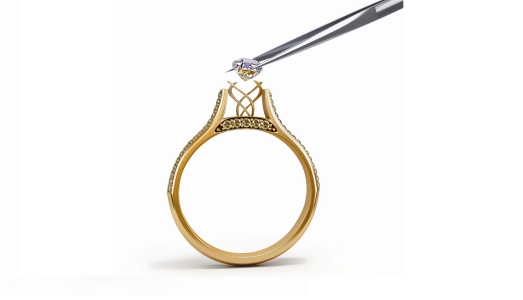Whether you’re just starting out in your jewellery making venture or looking for some inspiration for your designs, discover 8 types of stone settings in our blog. From flush setting to channel setting, we’ll talk you through how each technique looks, difficulty level and the basics of how to utilise each one. Learn more about the different stone settings in rings below.
What are the different types of stone settings?
1. Channel setting
Commonly used as a wedding ring design, channel setting is an ideal way to add something extra to your designs. Using two straight lines, an array of smaller stones are used to make a flush finish to the band. When trying out this technique, keep the seats small at first and gradually make them bigger to fit the stones in. This helps to ensure the fit is as accurate as possible. If you’d rather not set the channels yourself, you can buy a channel set ring to start the process.
2. Claw setting
Secondly, we have one of the most recognisable types of stone setting – claw setting. Also referred to as prong setting, this technique uses a stone between two or more claws and is commonly used with diamonds or coloured gemstones. Used in single stones and clusters, claw setting allows the most light into the stone out of all the types of jewellery settings. Find out more about how to make a prong setting on our blog.
3. Grain setting
Similar to pavé setting, grain setting uses small stones that are held together by tiny prongs. With no visible gap between the stones, this setting gives the appearance of a diamond encrusted ring. If you don’t feel ready to try this particularly fiddly technique, rings with a grain setting can be bought as a preset or made from a pre-existing band to help you get started.
4. Pavé setting
Pronounced “pa-vay”, pavé setting uses multiple smaller stones to cover a larger surface of a pendant or ring. To make the effect of a solid piece, all the stones are placed without gaps in between and small beads of metal are pulled from the surface to keep the stones in place. Although pavé setting isn’t technically challenging, there are a reasonable number of steps to follow – and they need to be performed precisely, so bear this in mind if you’re new to the technique.
5. Illusion setting
Out of the different types of jewellery settings we’ve discussed today, this is one of the most popular for engagement rings. The illusion setting lives up to its name, as the way the stone is set makes smaller diamonds appear larger than they are. To achieve this effect, the prongs hold the stone at each edge with a ‘bright cut’ to resemble the facet and diffuse the outline. With a similar technique to the bezel setting, beginners can move onto trying the illusion setting once the bezel setting has been mastered.
6. Bezel setting
Traditionally used to set cabochon stones, bezel setting is an ideal technique for beginners. With a simple process and classic appearance, bezel setting can be used by creating your own setting with bezel wire, or alternatively you can purchase bezel cups. Simply use a cup or your bezel wire before pushing a thin layer of metal to surround the stone and keep it in place.
7. Tension setting
One of the more unusual stone settings, tension setting involves two pieces of metal running either side of the stone, with a small groove for the stone to sit in. Ideal if you’re looking to add a personal touch to your pieces, you can manipulate the shape of the prongs that hold the stone in place. Considered a more advanced technique, if the metal holding the stone is misshapen it can lose tension and increase the risk of the stone coming loose.
8. Flush setting
Depending on how you control the tools, flush setting can be one of the easiest or most complicated stone settings. This is down to the fact that the seat needs to be the exact size of the stone, with very little room for error. Also known as gypsy setting, this technique is similar to channel setting, but instead uses a stone on its own. Using a burr, a groove is made around the seat so that the stone is sunken in leaving a flush, or level, finish with the rest of the band.
Now you know 8 of the top types of stone settings, it’s time to try them for yourself. Whichever technique you choose, make sure you have all the gemstones and jewellery tools you need before you start.

Joanna Varney
Joanna has worked in and around the jewellery industry for well over 20 years. She has designed and created her own pieces as a designer maker, as well as working in jewellery retail on a much larger scale, producing designs and NPD for some of the UK’s largest high street retailers

